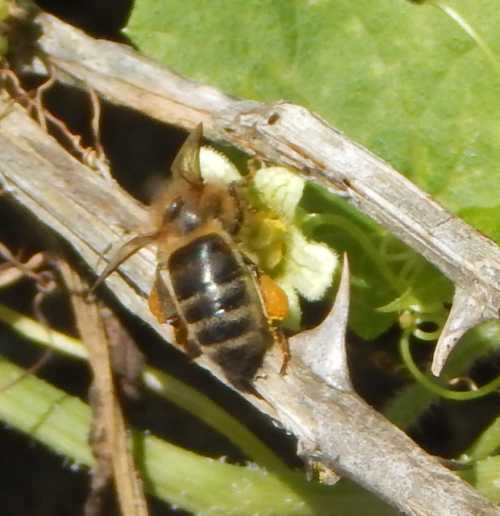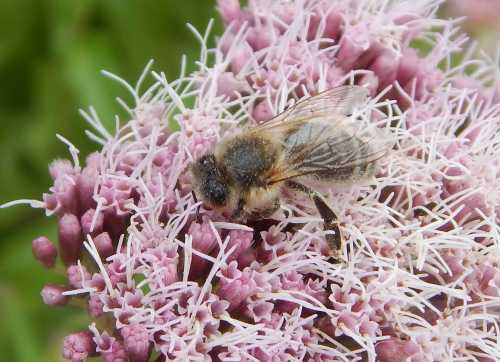Bumble Bees for Pollination: Why Are Bumble Bees Excellent Pollinators?
Updated: 1st March 2021
Gardeners have long known about the importance of bumble bees for pollination. It has to be said however, it is only in recent years that we have begun to understand how different pollinators, and indeed, different bee species, are sometimes better adapted to pollinating certain plants than others.
Whereas previously, honey bees have long been used by farmers for pollinating food crops, increasingly other bee species are also being recruited to help out.
For example, The
University of Georgia College of Agricultural Sciences advise farmers
that honey bees together with bumble bees, are better able to
pollinate blueberry crops and ensure higher yields, whilst some solitary
bees such as leafcutters and mason bees, are being used to pollinate
other crops.
However, it’s amazing to think that their use as effective and efficient pollinators for the commercial rearing of tomatoes was not discovered until the 1980s!
That said, I have reservations about the commercial rearing of bumble bees as you will see below. But for now.....
Bumble Bees for Pollination: Why Are They Such Effective Pollinators?
Here are 5 reasons why bumble bees are excellent pollinators:
1. Furry, fluffy coats
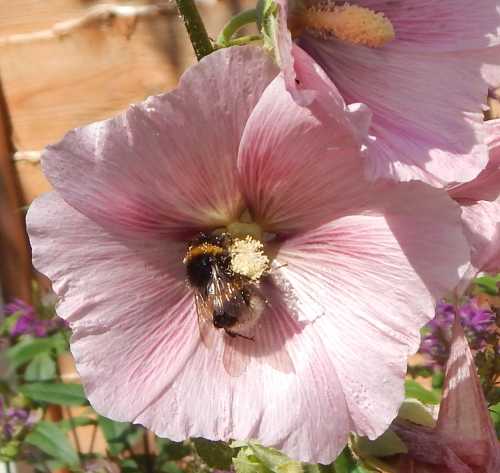 Gardeners have long known about the importance of bumble bees for pollination. Bumble bee on Hollyhock with pollen on its hairy body.
Gardeners have long known about the importance of bumble bees for pollination. Bumble bee on Hollyhock with pollen on its hairy body.Their coats are especially furry. This means their coats easily collect pollen, and transfer it to other plants.
In a study investigating raspberry pollination, it was found that their very hairy coats pick up even more pollen than the coats of honey bees (From: Bumblebees Behaviour and Ecology; Prof. Dave Goulson; citing Willmer et al 1994).
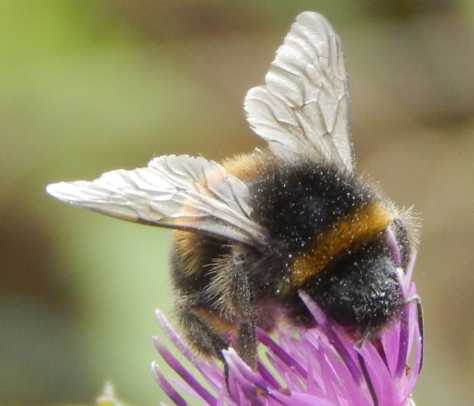
2. Long season across the species
Bumble bees also have long seasons. They are among the first of the bee species to emerge in the year, and some species may forage until November. They are therefore very important pollinators of early and winter crops.
However, it
is important they have access to good
bee plants (opens new window)
throughout the season, including during cool weather.
3. Long-tongued bumble bees
All bumble bees fall into the long-tongued category, meaning they are
attracted to, and particularly well suited to pollinating plants such as bean and pea
crops, and clover.
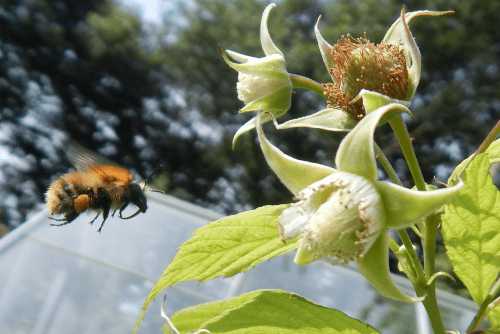 Common carder bumble bee flying toward raspberry flower, with curled tongue.
Common carder bumble bee flying toward raspberry flower, with curled tongue.4. Buzz pollination
Soft fruit and tomato growers are well aware of the efficiency of
bumble bees for pollination. Why is this so? It's because bumble bees
are capable of ‘buzz pollination’. Here, the bumble bee places its
thorax (upper body) close to the anthers of a flower, and vibrates its
flight muscles. This vibration shakes the pollen from the anthers, and
enables efficient pollination of tomatoes, kiwi fruit and cranberries and other crops.
Buzz pollination is also especially beneficial in blueberry pollination and strawberry
pollination. Even where crops can be self pollinated (as in some
tomatoes), nevertheless, they produce more and bigger fruits with the
aid of bumble bees for pollination.
5. Super-speedy pollinators
Bumble bees are also super fast pollinators!
Under the same
conditions, bumble bees actually pollinate more flowers per bee than
honey bees (from: Bumblebees Behaviour and Ecology; Prof. Dave Goulson;
citing Poulson 1973; Free 1993).
Note, typical bumble bee colonies may consist of as few as 40 workers, or reach around 120 workers (read about the bumble bee life cycle).
Less common, but also possible, would be a colony of 400 workers. Honey bee colonies by contrast, are much larger, with 20,000 to 50,000 workers.
However, studies have demonstrated that 5 colonies of bumble bees, B. Impatiens, per hectare of lowbush blueberry, produced yields equal to using 7.5 honey bee colonies per hectare, despite the significantly greater size of honey bee colonies. (From: Bumblebees Behaviour and Ecology; Prof. Dave Goulson; citing Van Heemert et al 1990; Ptácek 1991; Whidden 1996; Stubbs and Drummond 2001).
However, honey bees remain important pollinators for other crops, such as almonds. There are also other reasons why honey bees matter.
Commercial rearing of bumble bees for pollination
Over the years, a steady increase in the commercial rearing of bumble bees for pollination has been evident. Unfortunately, this has not always been a blessing.
In the USA, farmers were allowed to transport commercially-reared, non-native bumble bees onto their land for pollinating crops.
Unfortunately, this has spread diseases, with consequences for local populations of wild bees. Xerces, the US invertebrates conservation charity, along with a number of other organisations, submitted a petition to the USDA’s Animal and Plant Health Inspection Service, requesting laws to protect wild bumble bees from disease by regulating the movement and health of commercial bumble bees outside their native ranges.
Read about the risks of commercial bumble bee pollination.
If you found this page helpful or interesting, I'd really be grateful if you would share it with others - if not this page, perhaps another, such as Gardening For Bees.
Thank you so much :) .
